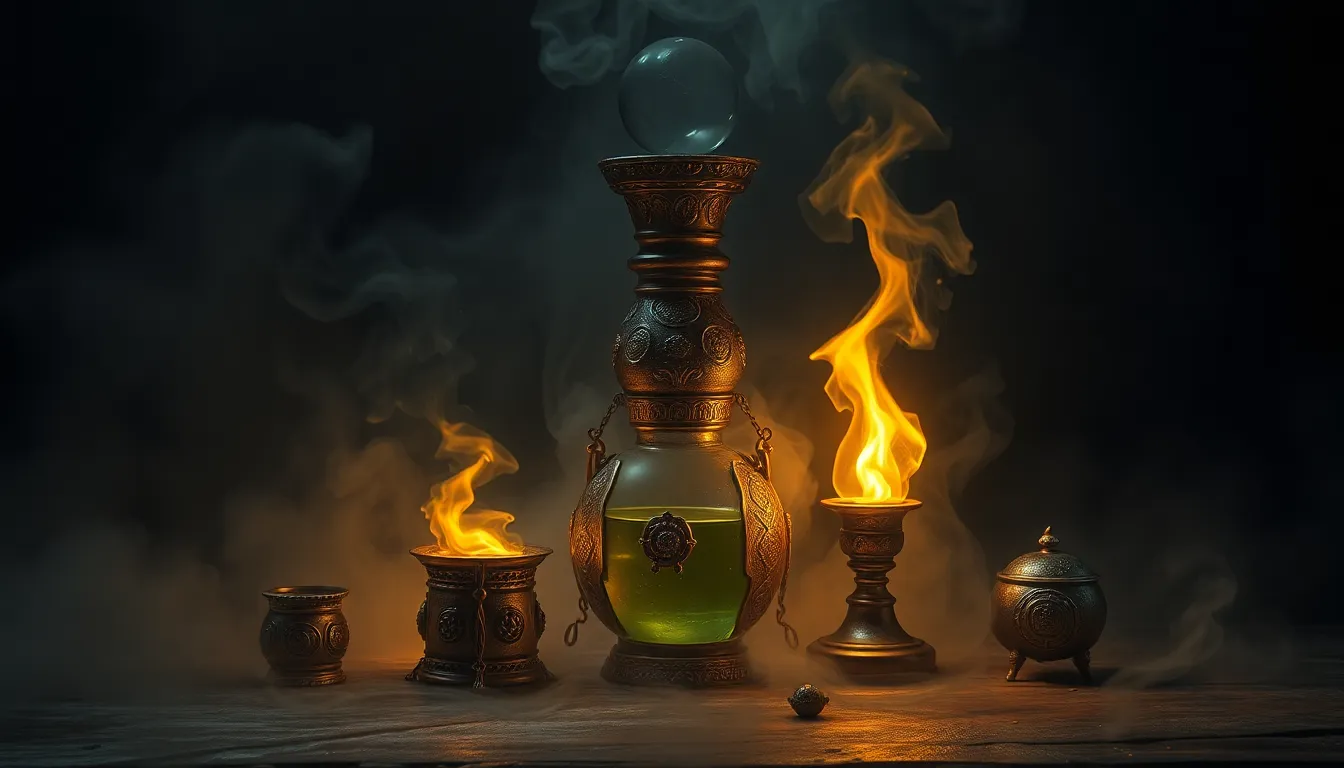The Art of the Alchemist: 5 Magical Artifacts You Should Know About
I. Introduction to Alchemy
Alchemy, a philosophical and proto-scientific tradition, has captivated human imagination for centuries. Often regarded as the precursor to modern chemistry, it blends scientific inquiry with mystical and spiritual elements. Alchemical practitioners, known as alchemists, sought to transform base materials into noble substances, discover the secrets of immortality, and uncover the mysteries of existence.
The historical context of alchemy dates back to ancient civilizations, including Egypt, China, and Greece. It served not only as a precursor to modern scientific practices but also as a spiritual journey toward enlightenment and self-discovery. Central to alchemical practice are magical artifacts, each imbued with symbolic significance and believed to possess transformative powers.
II. The Philosopher’s Stone
A. Origins and Mythology
The Philosopher’s Stone is perhaps the most famous of all alchemical artifacts. Its origins can be traced back to ancient texts, where it was described as a substance capable of turning base metals into gold and providing immortality. Mythology surrounding the stone often portrays it as an elusive object of desire, sought after by countless alchemists throughout history.
B. Symbolism of Transformation and Perfection
In alchemical symbolism, the Philosopher’s Stone represents ultimate transformation. It embodies the idea of perfection and the attainment of the highest spiritual state. Alchemists believed that through the creation of the stone, one could achieve not only material wealth but also spiritual enlightenment.
C. Alleged Properties and Powers
- Ability to transmute base metals into gold.
- Provision of the Elixir of Life, granting immortality.
- Symbol of spiritual completion and enlightenment.
III. The Elixir of Life
A. The Quest for Immortality
The Elixir of Life is another legendary artifact in alchemical lore, often associated with the Philosopher’s Stone. This miraculous potion is said to grant eternal life and youth to those who consume it. The quest for the Elixir has driven many historical figures, including emperors and scholars, to pursue the secrets of alchemy fervently.
B. Historical Figures and Their Pursuits
Notable historical figures such as Nicolas Flamel and Paracelsus are often cited in tales of the Elixir’s pursuit. Flamel, a 14th-century French scribe, became a legendary figure in alchemical circles, rumored to have discovered the Philosopher’s Stone and created the Elixir of Life.
C. Theoretical and Practical Implications in Alchemy
The pursuit of the Elixir of Life highlights the intersection of alchemy with human desires for immortality and transcendence. The implications of this search extend beyond physical longevity, as it invites contemplation of spiritual and philosophical dimensions of existence.
IV. The Alchemical Cauldron
A. Significance in Alchemical Processes
The cauldron is an essential tool in alchemical practices, symbolizing transformation and the vessel within which elemental changes occur. It represents the womb of nature, where raw materials undergo metamorphosis into higher forms.
B. Symbolic Meaning of Transformation and Creation
In many alchemical texts, the cauldron is associated with the process of creation. The alchemist’s work is often likened to that of a divine creator, manipulating elements to bring forth new life and understanding. This symbolism extends to the idea of personal transformation, as the alchemist seeks to refine their own soul.
C. Notable Legends and Stories Associated with Cauldrons
- The cauldron of Dagda in Irish mythology, which provides infinite sustenance.
- The cauldron of resurrection from Arthurian legends, symbolizing rebirth.
V. The Emerald Tablet
A. The Text and Its Historical Background
The Emerald Tablet, attributed to Hermes Trismegistus, is a foundational text in alchemical literature. Its succinct yet profound statements encapsulate the essence of alchemical philosophy and practice. The tablet’s historical context is intertwined with the blending of Greco-Roman and Egyptian thought.
B. Key Concepts: “As Above, So Below”
One of the most famous maxims from the Emerald Tablet is “As above, so below.” This phrase signifies the interconnectedness of all things and suggests that understanding the cosmos can lead to understanding oneself. It emphasizes the alchemical belief in the correspondence between the macrocosm and microcosm.
C. Influence on Modern Alchemy and Esoteric Practices
The Emerald Tablet has influenced not only alchemical practices but also various esoteric traditions, including Hermeticism and Kabbalah. Its teachings continue to resonate with those seeking deeper spiritual understanding and mastery over the self.
VI. The Philosopher’s Egg
A. Description and Symbolism
The Philosopher’s Egg, often depicted as a perfect sphere or egg shape, symbolizes the potential for transformation and the unity of opposites. It represents the alchemical process of uniting spirit and matter to create the Philosopher’s Stone.
B. Role in Alchemical Transmutation
In the context of alchemical transmutation, the Philosopher’s Egg serves as a metaphor for the alchemist’s journey toward enlightenment. It embodies the notion of gestation and the birth of new realities through the alchemical process.
C. Interpretations in Various Alchemical Traditions
Different alchemical traditions interpret the Philosopher’s Egg in unique ways. In some Eastern traditions, it represents the cosmic egg from which the universe is born, while in Western alchemy, it symbolizes the unity of the four elements.
VII. The Alchemist’s Wand
A. Significance of Wands in Alchemical Rituals
The wand is a powerful symbol in alchemical rituals, representing the will of the alchemist and their ability to direct energy. It is often used in ceremonial practices to invoke transformation and establish a connection with higher realms.
B. Materials and Their Symbolic Meanings
Alchemists crafted wands from various materials, each carrying its own symbolic meaning. Common choices include:
- Wood: Represents growth and life.
- Crystal: Symbolizes clarity and spiritual insight.
- Metal: Denotes strength and permanence.
C. Connection to Modern Magical Practices
The use of wands in modern magical practices, such as Wicca and ceremonial magic, is heavily influenced by alchemical traditions. They serve as tools for focusing intention and manifesting desires in the physical world.
VIII. The Role of Magical Artifacts in Alchemical Practice
A. How Artifacts Enhance Alchemical Work
Magical artifacts play a crucial role in the practice of alchemy. They enhance the alchemist’s ability to manipulate substances, channel energies, and achieve desired transformations. Each artifact carries its own vibrational frequency that interacts with the alchemist’s intent.
B. The Relationship Between Artifacts and Spiritual Growth
Using these artifacts fosters spiritual growth and self-discovery. The process of working with magical tools encourages introspection and the refinement of one’s character, aligning the practitioner closer to their higher self.
C. Contemporary Practices Inspired by Ancient Artifacts
Many contemporary practitioners of magic and spirituality draw inspiration from ancient alchemical artifacts. They incorporate these tools into their rituals, seeking to connect with the wisdom of the past while forging their own paths of transformation.
IX. Cultural Representations of Alchemical Artifacts
A. Alchemy in Literature and Popular Culture
Alchemy has left an indelible mark on literature and popular culture. From the works of J.K. Rowling, with the Philosopher’s Stone central to her series, to the philosophical musings found in classical texts, alchemy continues to inspire storytellers and creators.
B. Artistic Depictions of Alchemical Processes
Throughout history, artists have been fascinated by the visual representation of alchemical processes. Paintings, illustrations, and sculptures often depict the transformation of substances and the symbolic journey of the alchemist.
C. The Legacy of Alchemical Artifacts in Modern Society
The legacy of alchemical artifacts persists in various forms in modern society. They inspire




